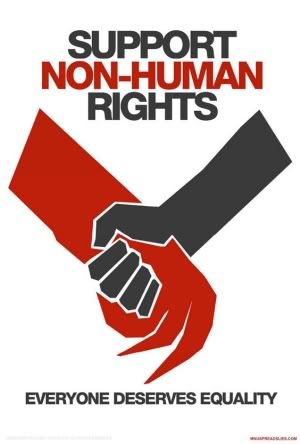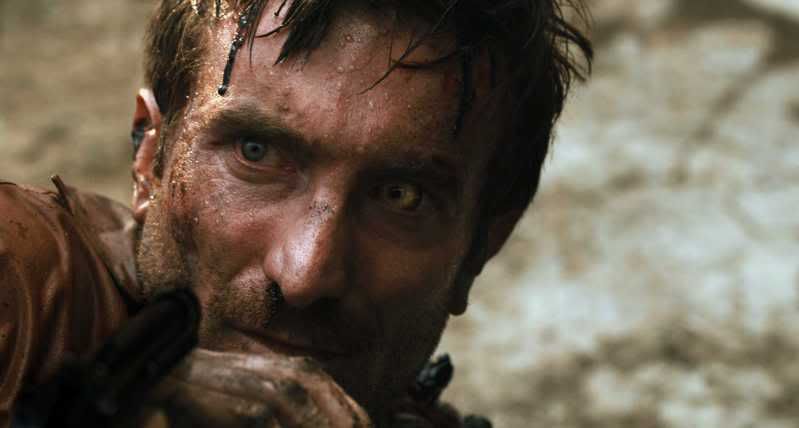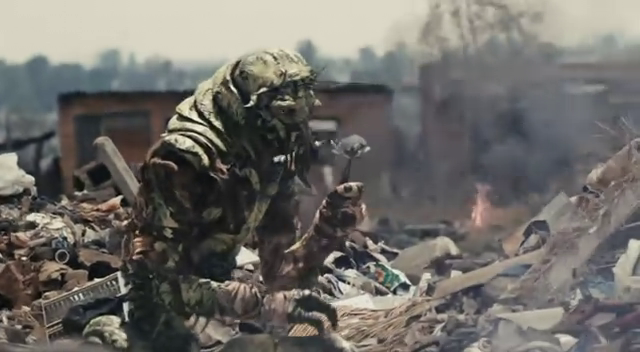 |
| Fig. 1 District 9 poster. |
District 9 is Neill Blomkamp's feature film debut and what a debut it was!
 |
| Fig. 2 Wikus' struggle with his metamorphosis. |
This film is a great example of what can be achieved with a low budget and a lot of care and attention. District 9 was given $30 million, a fairly low budget for a feature film, but received revenue of
almost 7 times more from its box office release. Despite the low funding the effects look absolutely stunning. The director had been in involved in the special effects for his previous short films, but the addition of WETA Workshop in New Zealand to the project meant that nothing in this science fiction film would appear at all fictional. Robert C. Ring expressed that "
The special effects are superb, but they don't exist to be showcased. they are used to strengthen an engaging story." (Ring, 2011:94) All of the CGI and special effects look fantastic and real, it is clear that they were based on pre-existing objects to make them more believable, but they don't detract from the narrative. A narrative that explores the emotional struggle of the central characters and also the underlying racial issues associated with South Africa. As Ring goes on to explain, that "
It's easy to pass District 9 off as a simple apartheid analogy, but its concerns are much broader than that. This is a film about the horror of great change. It is about being placed in a situation so dire that all you can do is fight, even though there's virtually no chance of escape. It is about hope and the disappointment of hope unfulfilled." (Ring, 2011:94-5) this 'great change' is visually represented by the horribly physical metamorphosis that Wikus, the main character, suffers through. Again, these effects look great but don't detract from the more serious issues that the film portrays.
 |
| Fig. 3 Welcome to District 9. |
Although Ring describes the film as not being a '
simple apartheid analogy', it is perhaps this analogy that is the most significant to the narrative and the director. Roger Ebert divulged that "
The title District 9 evokes Cape Town's historic District 6, where Cape Coloureds owned homes and businesses for many years before being bulldozed out and relocated." (Ebert, 2011) Not only is the title significant here, but the scenes when the aliens are being forcefully evicted from their homes mirrors what happened in Cape Town. The similarities don't end there as Ebert continues "
the alien language incorporates clicking sounds, just as Bantu, the language of a large group of African apartheid targets." (Ebert, 2011). Although the aliens have minimal resemblance to humans, their actions and language are directly linked to them. The apartheid was an example of humanity's ability to use its own greed and ignorances to segregate those they viewed as inferior and prevent them from ever having equal experiences. He then explains that "
there's a harsh parable here about the alienation and treatment of refugees." Which is never more relevant than it is now. At a time when war is rife in under-privileged countries, such as Afghanistan, refugees are seeking help from wherever they can, and whether they receive it or not is totally dependant on their host. In D
istrict 9 the aliens are stuck in Johannesburg, a city already known for its violence, so they treat the aliens with hostility and fear. Keeping what is different and misunderstood seperate from them, in an attempt to keep their own quality of life from being affected. A technique used in the film to increase the reality of these situations is the 'mockumentary' style of filming. It is filmed in the same way as a real documentary would be but it consists of entirely fictional material. this allowed the narrative to be non-linear in nature but contain large sections of linear plot so not to detract from the story. Stephen King mentioned on the subject of 'mockumentary' films that "
Not until District 9 do we find genius perfected. It's not "pure," if we take that to mean absolute adherence to the idea of amateurs with cameras - and of course D9's not a pure horror movie, either - but the technique allows the film to achieve a sense of reality that's seldom seen in the old monsters-from-space genre. With its use of mixed media - documentary footage, fake news reports, even what looks like home movies - District 9 is closer to Orson Welles' radio version of War of the Worlds than it is to an entertaining but ultimately disposable big-budget flick like Independence Day." (King, 2011) District 9's use of the fake documentary style filming has allowed it to surpass being a traditional or generic alien invasion movie and keep it from falling into the horror genre.
 |
| Fig. 4 The alien experience. |
Not only did the documentary style of filming effect the way the audience interpreted the narrative, but the use of colour within the mise-en-scene also added to the audience's view of tone. Julian Schürholz divulged that "
during the introductory interview with Wikus, the entire mise-en-scene is predominantly pastel-coloured...The same is true for the interviews. The effect is the creation of an impersonal, clean, and somehow "balanced" atmosphere." (Schürholz, 2010:9) The audience's first introduction to Wikus is important because they are supposed to feel that he is 'the good guy' as he works for the company that is supposed to look after the aliens. However, this sterile environment does not convey warmth of character at all, it in fact creates the opposite, a kind of cold, unfeeling atmosphere. A similar example is the choice of white paint jobs on the company's (MNU) vans. Schürholz believes it "
evokes allusions of the United Nations' peacekeeping troops... However, the soldiers being heavily armed, armoured, and dressed in all black, look nothing like the UN's "Blue Barrets" but more that Special Forces combat units." (Schürholz, 2010:9) White traditionally being associated with innocence and safety is now associated with the threat of violence and hostility. The examples of pastel and pure colours act as direct contrast to the mise-en-scene of the aliens slum home in District 9. Schürholz described the scenes in the alien slum as "
typically coloured a dusty brownish yellow, which is nolens volens evoking allusions to the real-world contemporary coverage by the so-called embedded journalists in the wars in Afghanistan and Iraq." (Schürholz, 2010:9) This is now visually reflecting the current situation in the war zones such as Afghanistan. When compared to the sterile colours of the human world, the aliens more natural colours, even in their dire living conditions, can be considered much warmer and less threatening.
Overall,
District 9 is a stunning example of the difference good design and art-direction can make to a film in the science-fiction genre. It is not only an exciting action adventure but a journey into humanity's fear of change and the cost it can have to those that suffer because of it.
List of Illustrations
Ebert, Roger (2011)
Roger Ebert's Movie Yearbook 2011. Missouri: Andrew McMeel Publishing LLC.
King, Stephen (2011)
Danse Macabre. London: Hodder and Stoughton
Ring, Robert C. (2011) Sci-Fi Movie Freak. USA: Krause Publications.
Schürholz, Julian (2010)
Mockumenting South Africa? Race and Segregation in"District 9". Germany: GRIN Verlag.






No comments:
Post a Comment